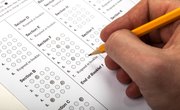The education process is a cyclical process between teacher and student that is continually moving. The education cycle focuses on planning, delivery and assessment in which both teacher and student are continually assessing whether or not the content and delivery was successful.
For the teacher, it is important to determine if the students received the information, retained it and were able to process it. For students, the process often involves making the determination if the content was effectively presented and whether or not the information was retained. Also, results of an assessment often give students critical information like ranking, overall performance and whether or not specific criterions were met in order to pass on to the next class.
Standardized Tests
A standardized test is, by definition, standardized. A standardized test includes the same format, same types of questions and the same content no matter when or where the test is administered or who is taking the test. Questions may be multiple choice, true/false or short answer, and it is administered either paper and pencil or on a computer.
Examples of standardized tests at the undergraduate level include the SAT, ACT and PARCC. Standardized tests often used for acceptance into graduate school include the LSAT, MCAT and GRE. These tests have been normed, and scores are ranked on a bell curve.
Standardized tests are further categorized by the way the scores of the tests are interpreted. Standardized tests are either norm-referenced or criterion-referenced. While the two types of tests have similarities, there are several major differences. The following section addresses the differences between norm-referenced tests and criterion- referenced tests.
Norm-Referenced Tests: Norm vs. Regular
Within the set of standardized tests, it is important to understand that there is a difference between norm-referenced and criterion-referenced tests. There is no difference between norm-referenced and standardized tests. While both tests are standardized, norm-referenced tests measure and rank test takers to each other. A test taker’s score is compared to the ‘norm’ of similar test takers and may be expressed as a percentile, grade equivalent or stanine.
There may be some misinformation regarding norm-referenced tests; however, the following is true of norm-referenced achievement tests:
- The goal of norm-referenced tests is to determine a test-taker's performance compared to a predetermined peer group
- Results determine what a student knows as an individual but also compared to a group
- Scores are distributed on a bell curve
The following is a norm-referenced test list:
- SAT
- PSAT
- ACT
- IQ Tests
Criterion-Referenced Tests
Criterion-referenced tests measure the number of correct responses based on a specific, often minimum ‘criterion’ of what is expected to pass the exam. Often, the criteria is what determines acceptable achievement or mastery of skill.
A criterion-referenced test score may be expressed in a percentage correct out of the total. Criterion-referenced tests measure individual performance to determine mastery of content or whether or not they mastered specific skills.
The following are examples of criterion referenced tests:
- Driver’s Education Test
- End-of-Unit Exam
- Pass/Fail semester exam
Norm-Referenced vs. Criterion-Referenced Tests
The two types of tests each serve a different purpose, and the scores are used differently. Schools and teachers may use norm-referenced test scores to rank student achievement across broad areas of knowledge. Another example of a norm-referenced score is a growth chart. Just as test scores, growth points are ranked in comparison to others in the same age group.
On the contrary, criterion-referenced scores may be used to determine if a student has mastered specific skills or concepts in specific areas of study. The example of driver’s education exam illustrates this concept. Test takers are not ranked by performance on the driver’s education exam. Instead they either pass or fail depending if they met the preset criteria.
Related Articles
References
Writer Bio
Melanie Forstall has a doctorate in education and has worked in the field of education for over 20 years. She has been a teacher, grant writer, program director, and higher education instructor. She is a freelance writer specializing in education, and education related content. She writes for We Are Teachers, School Leaders Now, Classroom, Pocket Sense, local parenting magazines, and other professional academic outlets. Additionally, she has co-authored book chapters specializing in providing services for students with disabilities.











